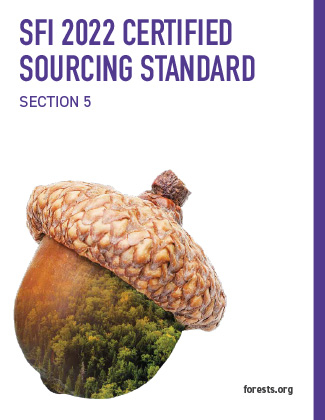SFI 2022 CERTIFIED SOURCING STANDARD
contains the requirements for SFI-certified organizations to use the SFI-certified sourcing claim and label. This standard also has measures to avoid controversial sources in the supply chain.
The SFI Certified Sourcing label tells buyers and consumers that fiber comes from a company that is certified to the SFI 2022 Fiber Sourcing Standard, or comes from recycled content, or from a certified forest. All fiber must be from non-controversial sources. Certified sourcing is defined in SFI Definitions (Section 14, SFI 2022 Standards and Rules).
The SFI requirements define two types of producers — primary and secondary.
Primary producers: Manufacturing units that manufacture forest products and source 50% or more (by weight) of their wood-based raw materials directly from primary sources. Primary producers can include companies that manufacture roundwood, wood chips, and/or composite products.
Secondary producers: Manufacturing units that produce forest products and source 50% or more (by weight) of their woodbased raw materials from secondary sources.
The SFI Certified Sourcing label does not make claims about certified forest content. Rather, it tells the consumer that the fiber in the product was purchased from responsibly managed forestlands.
SFI FOREST MANAGEMENT STANDARD
SFI FIBER SOURCING STANDARD
SFI ON DEFORESTATION/FOREST DEGRADATION
SFI CHAIN-OF-CUSTODY STANDARD
SFI CERTIFIED SOURCING STANDARD
SFI INDIGENOUS PEOPLES AND FAMILIES MODULE
SFI SMALL LANDS GROUP CERTIFICATION MODULE
SFI 2022 STANDARDS AND RULES (COMPLETE)
INTERPRETATIONS ON THE SFI 2022 STANDARDS AND RULES
SFI 2022 STANDARDS AND RULES REVISION PROCESS
CONFLICT TIMBER — RUSSIA AND BELARUS
Labels and Certification
Zachary Wagman
Senior Manager, Market Access
Tel: 613-745-3706
Standards
Gregor Macintosh
Senior Director, Standards
Tel: 778-351-3358
Program Participant Relations & SICs
Gordy Mouw
Director, Network Relations
Tel: 715-220-4132
Customer Affairs & Branding
Jason Metnick
Senior VP, Customer Affairs
Tel: 602-374-6539
Rachel Dierolf
Senior Director, Technical Operations & Reporting
Tel: 613-274-0124
FEATURED ARTICLE
NEW FOREST CERTIFICATION STANDARDS OFFERS NATURE-BASED SOLUTIONS TO THE CLIMATE CRISIS
The Sustainable Forestry Initiative’s (SFI) updated forest certification standards provide solutions to some of the world’s most pressing sustainability challenges. Sustainable forest management and the procurement of wood products from sustainably managed sources are critical tools that help avoid deforestation.


